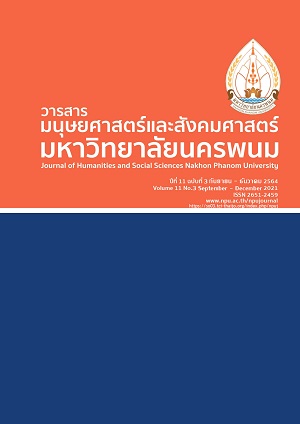An assessment An Assessment Model for Water Resource Management in the Lower Mekong Basin, The Lao People’s Democratic Republic -
Main Article Content
Abstract
The objective of this research is to evaluate the model of water resources management in the Southern Mekong Basin. There are 3 phases of research as follows: 1) Study economic, social, knowledge and needs in conserving natural resources, the environment, and participation at the household and workplace levels. The sample consisted of 194 people living in Pakse and 47 entrepreneurs in Pakse, totaling 241 people. 2) Develop the model of water resources management in the South Mekong Basin. Target groups are the Phon Kung village committee and Baan Lak Mueang, consisting of 46 people and representatives from the government agencies in Pakse, 18 agencies and 3) Assessment of water resource management model in the Southern Mekong River Basin. The target group are 30 representatives from Mueang Phon Thong District and 19 experts in water resources management. The research instruments are questionnaires, interview forms, group discussions and evaluation form. The statistics used for data analysis were percentage, mean, standard deviation and content analysis. The results show that in phase 1, Socioeconomic conditions, the sample group has an average household income of 201,151 baht / year and expenditures at the household level 122,714 baht/year, indicating that the overall economic conditions are good. Most of the respondents do not have debts. Social conditions of the respondents would obey the leaders and follow with government policies. When measuring knowledge needs and participation in the management of water resources in the Southern Mekong Basin Lao People's Democratic Republic found at moderate level ( X= 1.69, S.D. = 0.70). Phase 2: The development of a participatory water resource management model consists of 6 components : 1) principle, 2) objective, 3) system and mechanism, 4) management process, 5) evaluation and 6) success conditions. Phase 3 model evaluation results were found the management model was appropriate at a high level ( X = 3.53, S.D. = 0.89). The overall expert model assessment was found to be appropriate and feasible to a high level ( X= 3.69, S.D. = 0.76). In conclusion, an appropriate model for resource management in the Southern Mekong River Basin in Laos PDR must consist of 6 components for the study results to lead concrete practice and environment of champasak province. To propose to the district meeting and the party in the next step. And to determine the policy of the party in the water resource management of lower Mekong Basin.
Article Details
References
Chankao,K. (1997). witthayāsāt singwǣtlō̜m [Environmental science]. Bangkok : Kasetsart University.
Chankao, K. (2015). kānčhatkān lumnam [Warershed management]. Bangkok : Kasetsart University.
Chianchan, C. (2014). kānsāng læ kānphatthanā mō dē lō̜ / rūpbǣp / bǣpčhamlō̜ng / tūa bǣp [Modeling and development of models / models / models / models]. Silpakorn Journal of Research Science. Retrieved August 2018, From https: //www.tci- thaijo.org/index.php/suedureasearchjournal / article / download / 89954/70688/
Chandalasan, T. (2014). The Participation of Farmers Water User Group on Irrigation Water Management of Thintiengtay Irrigation Project, Pakngum District, Vientiane Capital, Lao PDR. Master of Science Program. Kasetsart University.
Cronbach, L.J. (1990). Essentials of psychological testing. (5th ed.). New York: Harper & Row.
pp. 202-204.
Department of Water Resources. (2006). kān bō̜rikān čhatkān nam bǣp phasomphasān [Integrated water management services]. 2nd edition. Bangkok : Office of Research and Development.
Kruekam, A. (2008). kānmī sūanrūam khō̜ng prachāchon nai kānʻanurak sapphayākō̜n nam nai phư̄nthī nō̜ng hān ʻamphœ̄ mư̄ang čhangwat sakon ืnakhō̜n [Public Participation in Water Resources Conservation in Nong Han Area, Mueang District, Sakon Nakhon Province]. Chiang Ma I : Chiang Mai University.
Planning and Investment Department. (2016). sathiti pračham pī sō̜ngphanhārō̜ihāsipčhet - sō̜ngphan hārō̜ihāsippǣt [Annual Statistics 2014-2015]. Champasak Province : Champasak Province Statistical Center.
Poondi, Y., Bunrueang, C., Suanmali, W. and Khumsuk, N. (2016) kānmī sūanrūam nai kānʻanurak khlō̜ng phō khō̜ng prachon tambon sām rư̄an ʻamphœ̄ bāng pa ʻin čhangwat Phra Nakhō̜n Sī ʻAyutthayā [Participation in the conservation of Khlong Pho of the people of Sam Ruen Subdistrict, Bang Pa-in District, Phra Nakhon Si Ayutthaya Province].Retrieved August 2018, From: http: //www.rdi. rmutsb.ac.th/2011/download/n59/8.pdf.
Runcharoen, T. (2007). rūpbǣp læ ʻongprakō̜p khō̜ng rūpbǣp [Format and Components of Style]. Khon Kaen : Faculty of Education Khon Kaen University.
Raphiphat, A. (1984). kānmī sūanrūam khō̜ng chumchon nai kānphatthanā chonnabot nai saphāp sangkhom læ watthanatham Thai [Community participation in rural development in Thai society and culture]. Bangkok : Center for Health Policy Studies Mahidol University.
Saikaew, W. (2016). theknōlōyī sukhāphibān [Sanitation technology]. Ubon Ratchathani : Faculty of Science Ubon Ratchathani Rajabhat University.
Serirat, S., Serirat,S., Meechinda, P., Lertwanawit, O., Laksitanon, P., Parnavanit, O. and Anuchanon, C. (2009). kānbō̜rihān kāntalāt yuk mai [Modern marketing management]. Bangkok : Thammasarn Company Limited.
The Stock Exchange of Thailand. (2014). khai khwāmmāi kānphatthanā yāng yangyư̄n [Unlocking the definition of sustainable development]. Bangkok : Wanida Printing LP.
Thaen-nga, S., Pho-ngam, C. and Phianchana, A. (2017). kānchai prayōt panhā khwāmtō̜ngkān læ nǣothāng phatthanā nai phư̄nthī lumnam lam dōm nō̜i čhangwat ʻUbon rātchathānī [Uses, problems, needs and development guidelines. In the Lam Dome Noi Basin Ubon Ratchathani Province]. Journal of Humanities and Social Sciences Nakhon Phanom University, 9(2) ; 121-128.


